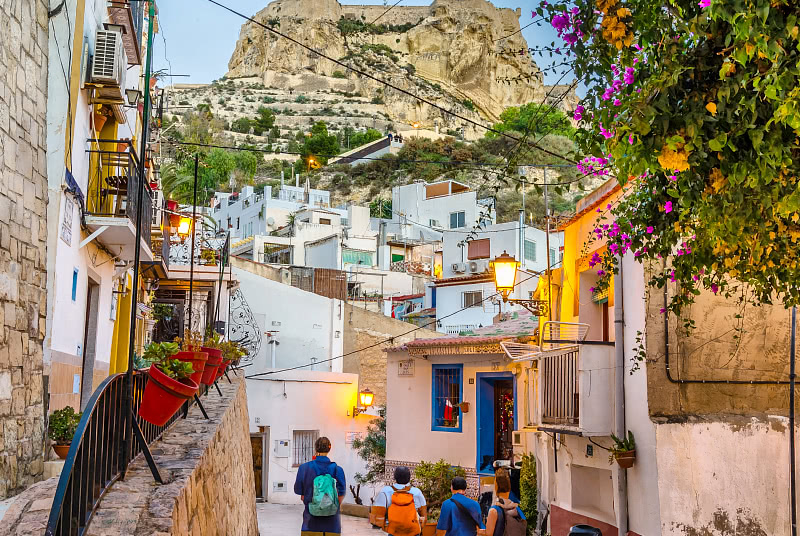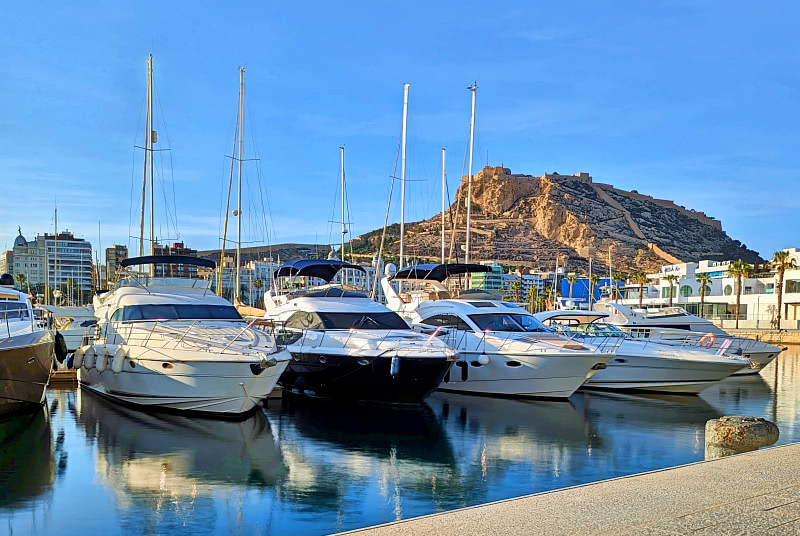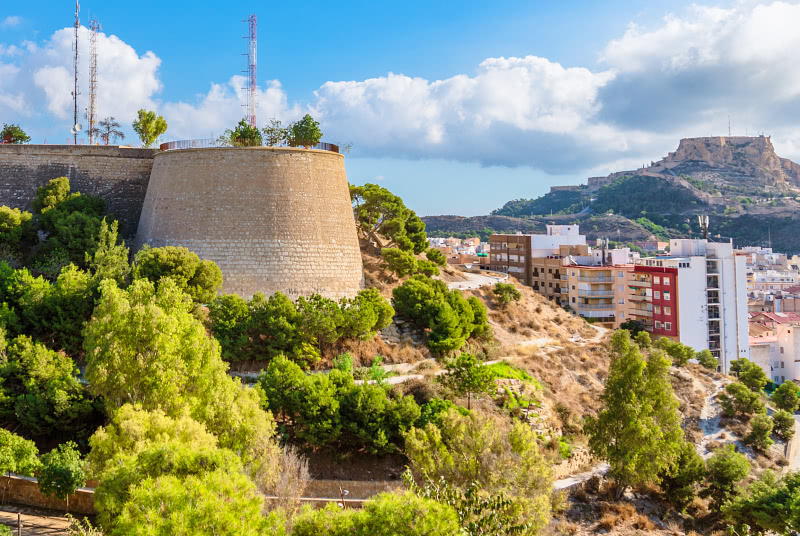Districts and areas of Alicante

This page introduces you to Alicante's main areas and neighborhoods. For travelers, the most important ones are the old town, the newer parts of the city center, and the port area.
The old town (El Barrio and Barrio de Santa Cruz) is where you'll find the historic sights, atmospheric streets, and buzzing nightlife that give Alicante its character. Head to the newer side of the center, especially the Centro and Diputación Ensanche areas, for great shopping, plus you'll find plenty of restaurants and excellent transport connections there. Down by the port, the waterfront promenade and marina are the main draws, it's a perfect spot to take in views of both the Mediterranean and Mount Benacantil.
We'll also cover the Mercado and Campoamor neighborhoods, which often fly under the radar for many visitors, as well as the San Antón and La Goteta areas.
About Spanish and Valencian languages
In Alicante, you'll mostly hear Spanish being spoken, but lately, Valencian (valenciano) has been making quite a comeback. These days, you'll spot Valencian names everywhere, on street signs and in official contexts, and they can look pretty different from their Spanish counterparts.
Many places in the Valencia region actually go by two different names. Take the city itself: in Spanish, it's Alicante, but in Valencian, it's Alacant.
Online maps can be a bit of a mixed bag when it comes to street and square names, they tend to flip-flop between Spanish and Valencian. You might see a street labeled as "carrer" (Valencian) in one spot and "calle" (Spanish) in another. Same goes for squares: in Spanish, it's "plaza," while in Catalan (and Valencian), it's "plaça."
Don't worry if this sounds confusing, tourist maps usually stick to Spanish and English, so you'll find every street address written in Spanish.
In this guide, we typically just use the street's actual name without adding "carrer" or "calle" in front. Sometimes we'll use the abbreviation C/ before the name, just like you'll see on the street signs themselves.
Alicante's Key Areas and Neighborhoods from a Tourist's Perspective
When you're in Alicante, there are three main areas you absolutely need to check out: the old town, the modern city center right next to it, and the harbor area.
The old town is hands down the most charming spot for wandering around and soaking up the atmosphere. Meanwhile, the modern part of the center is where you'll want to go for shopping and treating yourself to some seriously good food. And the harbor? Well, that's essential for experiencing Alicante's seaside vibe, you'd be missing out if you didn't spend some time there taking it all in.
While these three areas are the main draws for tourists, venturing into neighborhoods beyond the center can be really rewarding too. You'll find all sorts of attractions, shopping centers, and places to stay. Not everyone has time to explore these outer areas, but if you've got some spare time on your hands, definitely pop over for at least a quick visit.

Old Town
Alicante's old town is a charming area made up of two distinct parts: the main old quarter (known as El Barrio or Casco Antiguo) and the Barrio de Santa Cruz.
Just a few decades ago, this area had a dodgy reputation and was best avoided, but these days it's completely transformed, now it's a favorite hangout for both locals and tourists alike. The old town is where you'll find historic sights, quirky little shops, great restaurants, and buzzing nightlife.
The main drag, C/ Mayor, is packed with excellent shops and eateries. Along this street, you'll find the tourist-friendly dining area around Plaza Santísima Faz [on map] and the town hall with its square (Plaza del Ayuntamiento) [on map]. C/ Mayor continues as C/ Villavieja, where you'll spot the prestigious MACA contemporary art museum facing the Gothic-Baroque Santa María church [on map].
Keep walking past the church and you'll discover quiet blocks dotted with bars. Head toward the beach and you'll come across MUBAG, the fine arts museum [on map], plus a handful of specialty shops and bars along Gravina street. As you approach the port and Plaza Puerta del Mar, you'll hit C/ San Fernando [on map], which is part of the downtown's trendy La Zona district. This is the go-to spot for tapas and dining, with a vibrant nightlife scene to match.
Fair warning: the old town can be quite hilly and challenging to navigate in places, so it's not ideal if you have mobility issues or are pushing a stroller. The area around Plaza del Carmen [on map] has some steep ups and downs, though things level out near the market hall. Don't miss Plaza de San Cristóbal [on map] either, it's worth checking out for its lively evening scene.
The New Downtown Districts: Centro and Diputación Ensanche
The newer parts of downtown, Centro and Diputación Ensanche, sprawl across a vast area between the main train station and the old town. It's a big zone, so it helps to know where you're headed.
From the main train station, you can catch long-distance trains to places like Barcelona and Madrid, or hop on local trains to Elche and Murcia.
The area around the station has some great shopping streets, like C/ Serrano and Avenida de la Estación, lined mostly with big-box stores. Unlike the old town, shops in Centro don't close for siesta and stay open on Sundays too.
Avenida de la Estación leads to Luceros square [on map], which is Alicante's main tram hub. From here, you can catch trams to Benidorm, El Campello, and San Juan, among other destinations.
From Luceros square, a lovely tree-lined boulevard named after Federico Soto runs down to the harbor. It's got a pleasant vibe and some shops scattered along the way.
For serious shopping in this area, hit up Maisonnave street, it's where you'll find some of the city's best-known stores and department stores.
Federico Soto continues as Gadea street, which takes you to the harbor area and Muelle Poniente street [on map]. This is where you'll find the city's bus station, the Panoramis shopping center, and the Sala de exposiciones Lonja del Pescado art gallery, housed in the old fish market buildings.
Beyond Federico Soto, you're in the heart of Centro proper.
The area is packed with shops, restaurants, and places to stay. The nicest parts are near the harbor and along Calle San Fernando, which has several excellent restaurants. This is part of La Zona, the city's buzzing hub for tapas bars and nightclubs. Two lovely squares worth checking out are Plaza Gabriel Miró [on map] and Plaza Nueva [on map], both surrounded by plenty of boutiques and cafés.
One of the main arteries of the new downtown is Avenida Alfonso X el Sabio, it's busy but great for shopping, with hotels, banks, stores, and restaurants lining both sides.
The Mercado Central de Alicante market hall [on map] is also along this avenue, and you can easily get there by tram.
From the market hall, Rambla Méndez Núñez (or simply "the Rambla") is one of the city's key streets, lined with quality restaurants and various shops. Near the market hall, you'll also find Teatro Principal, the city's main theater.
The Rambla ends near the harbor at Plaza Puerta del Mar square [on map].

Harbor Areas
Alicante's harbor is split into two main areas: the marina (Marina), which you'll find along Muelle Levante street, and the commercial port, located near Muelle Poniente street.
While the Muelle Poniente side doesn't offer much in terms of sightseeing, the harbor area is definitely worth exploring. One of the highlights is strolling along the palm-lined promenade that stretches from one end of the port to the other and continues for another kilometer along the coastline. It's a popular spot that draws plenty of walkers, cyclists, and joggers throughout the day.
The promenade ends at Plaza Puerta del Mar square [on map], which serves as the gateway to the harbor. On one side of the square, you'll find the port surrounded by terraces, nightclubs, bars, and restaurants. On the other side lies the gorgeous fine-sand city beach, Playa del Postiguet.
A beachfront boulevard runs along the shoreline, lined with terrace restaurants, playgrounds for kids, and plenty of spots to sit and relax. From the beach, you'll get stunning views of Mount Benacantil and the impressive
Santa Bárbara Castle perched on top.
Beyond Plaza Puerta del Mar, you'll reach the heart of the Marina, where you can wander around, check out various boats and yachts, visit the Ocean Race sailing competition museum [on map], or grab a meal and enjoy the nightlife. Near the museum, you'll find several highly-rated restaurants, a casino, and various accommodation options.

Mercado – Campoamor
Just north of the Central Market, you'll find Alicante's Mercado and Campoamor neighborhoods. While they might not be on every tourist's radar, these areas have plenty to offer. The districts stretch all the way to San Fernando Castle [on map], with sports facilities sprawling behind it, including the city's football stadium.
The parkland surrounding San Fernando Castle atop Monte Tossal hill is definitely worth checking out, especially if you're into nature or traveling with kids. The views from up there are absolutely breathtaking, and the green spaces offer a welcome escape from the busy streets during peak tourist season or scorching hot days. There's plenty to do in the park, with the best variety of activities available on weekends and during summer months.
Behind the park, you'll discover extensive sports complexes complete with training fields, an athletics stadium, and the main football stadium. Alicante's Hercules football club plays their home games at the stadium [on map]. Match tickets won't break the bank, and the football season typically runs from late August through the end of May.
San Antón, La Goteta
If you venture beyond Alicante's castle hill area, you might find yourself exploring the neighborhoods of San Antón and La Goteta. Both offer places to stay, shopping opportunities, and some interesting sights worth checking out.
In San Antón, near Plaza de España [on map], you'll find the city's bullring, complete with its own museum. Now, bullfighting is a controversial topic that many travelers find ethically problematic, so it's understandably not on everyone's must-see list. That said, the museum does offer insights into this divisive cultural tradition if you're curious to learn more. Nearby, there's also a cultural center called Centro Cultural Las Cigarreras, which hosts all sorts of events and exhibitions throughout the year.
La Goteta is easily accessible by tram from various points in the city, including the central market area, Luceros train station, and even from the Benidorm area. The neighborhood's star attraction is the MARQ Archaeological Museum, one of the most cutting-edge archaeology museums in Southern Europe.
Another reason to head to La Goteta is the massive Centro Comercial Plaza Mar 2 shopping mall [on map], which has its own tram stop for easy access.
Right next door, you'll find the Palacio de Congresos de Alicante conference center [on map], surrounded by hotels, restaurants, and a supermarket.